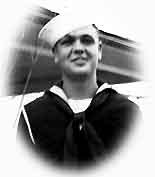| Tom Gale, USS Canopus |
Home Main Hanawa Page Hanawa Yank Roster
|
|

|
|
Thomas Oakley Gale,
Serial # 3560676, was on the USS CANOPUS, AS-9.
His rate was Electrician's Mate Third Class (EM3c). According
to the Muster Roll of the Crew, he enlisted in the US Navy on
9 October 1941 and was received onboard CANOPUS on 9 July
1941. That seems to be backwards but that is what the Muster
Roll says. Perhaps the date of enlistment is when he reenlisted
while serving on CANOPUS. For the quarter ending March
1942, Thomas is listed as an EM2c, with the same "enlistment
date" and the same "received on board date." He is also listed at the end of February, 1942 with a change of status to EM2c. From this information one can draw some basic conclusions: Since Thomas was listed as present at the end of December 1941, it would indicate he was present when the war began and CANOPUS was at anchor 1000 yards from the Cavite Naval Station. He went through all the bombings and air attacks while the ship was docked at the piers as well as the attacks while the ship was moored to the shoreline in Mariveles Bay. In February 1942, a major transfer of crew took place when some 371 sailors transferred at one time out to Corregidor. Thomas is not listed as one of them so we can assume that he was like my Uncle, S1c Paul Edward Perry, and was taken out to Corregidor with the last groups to go when Bataan fell on April 9, 1942. That would have placed Thomas on Corregidor for the last month that the defenders were able to defend. As Bataan fell on April 9, the last of the CANOPUS crew and other Navy personal were taken out and put on beach defenses of Corregidor, where they lived for another month in caves and foxholes along the beaches. This was the worst time to be on Corregidor as estimates state that upwards of 10,000 shells fell in one single 24 hour period. On the 6th of May the entire garrison of Corregidor surrendered as machine gun bullets bounced off the iron doors of the tunnels. From there, they were rounded up and made to spend the next three weeks on the seaplane ramp and in the 92nd Garage area with little food, water, shade and sanitation. There are captured Japanese photographs available of the surrender. After three weeks, almost the entire group of around 10,000 disheveled POWS were taken by freighter to Manila, paraded through the streets at bayonet point, as the Japanese guards stood by in their finest dress uniforms. The Prisoners were marched into Bilibid Prison, an abandoned military prison, hastily converted into a prison for the Corregidor men. |
|